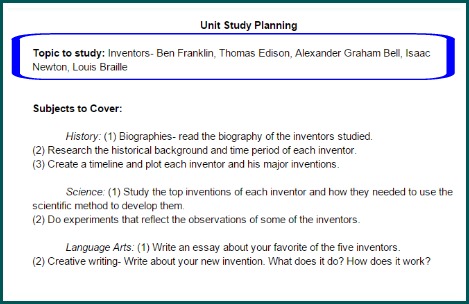Teaching with unit studies is a great way to include children of multiple ages all at once. It’s also a great way to take a topic children are interested in and teach things they need to know using that interesting subject matter. There are packaged unit studies you can purchase (or sometimes find free online). But it’s not difficult to pull together your own study on any topic you want to study. Here’s a step by step guide to planning your own unit study.

Choose a topic
Often unit studies are a great way to follow a child’s passion. Does your child have a topic that particularly interests him? Is there a subject he loves to read about or talk about it? Even if the topic doesn’t seem “educational”, there are often many ways to incorporate it into your learning.
Unit studies can also be a good way to expand another topic you’ve been studying. If you’re doing a science course about astronomy and you and your child have had an interesting time reading about the planets, you could pick a planet to do a more in depth unit study on. If you’re reading about American history and Westward expansion, perhaps there is a particular explorer that you’d like to learn more about with a unit study.
I’m going to use the example of a unit study about five well-known inventors as I go through these steps. This topic might have come up because children are interested in their inventions and want to know more about them. Or it might have spun off of a history study about the Industrial Age or a science study that involved the findings of one of them.
Think about what academic subjects you’d like to cover
Not every unit study has to cover every school subject. But if you use unit studies as your primary curriculum, you’ll probably want to make sure that you are covering any relevant subjects. Make a list of the subjects you want to cover in your unit study. Just list them out on a piece of paper for a simple plan or make a spreadsheet if you want a little more structure and detail.
As you continue through your unit study planning and as you collect resources, make notes under each subject when you have material that will cover that subject.
For our inventors study, I want to cover some history, science, and language arts skills. I’ve mentioned a few things I know I want to cover, but this list will likely grow as I begin to collect some resources and have an idea of what we’ll be reading.
Gather books and websites
I think the best place to start finding relevant books is on the internet. I like to Google “books about …” and find sites where other moms and homeschoolers have listed books they used to study the topic. There are many great book lists online. And some of them contain suggestions of books that can be read for free- either online or as a free Kindle book.
Once you have some ideas, then pull up your library website. You can search for the books you want and put them on hold or request them in inter-library loan. And if you don’t think you have enough books yet, you can search your library’s database for the subject.
For our inventors study, I’ve listed a few books and websites I plan to start with. Often more materials come up as we’re studying the original materials.
Find or make printables
Again, I start this step with a google search. “Printables for…” can often turn up tons of free printables. If you can’t find a printable you need- such as the timeline in our example above- then you can make it yourself using any simple word processing program.
For our example study, I’ve listed just a few pages that had free printables when I first searched. You can use the specific skills you want to study to narrow down that printable search.
Write out some- flexible!- daily lesson plans
One of the beauties of unit studies is the flexibility. You can spend more or less time on a topic depending on your interest and time available. Search sites and actually make a lapbook or notebook or just read and do some activities. You can really make it as detailed as you like.
Although you can be flexible, it is very helpful to make a loose daily schedule at the beginning. That way if you have specific materials or skills you want to cover, you will make sure that those are really covered. This schedule can be more general- like a checklist of things to cover- or more specific- like a daily schedule with everything planned out.
For my example, I started a checklist of activities I wanted to complete in our study. I may complete several in a day, or I might spend a whole day on one if we are really interested.
It can be simple- and fun!- to plan your own unit study. It can give your family flexibility to study the things that you enjoy and want to learn about. With the help of the internet and your local library, it’s easy to pull together the resources you need.
Leah Courtney is a homeschooling mom of four. Her days are filled with being a mom, homemaker, and teacher. In her (very rare) free time, she enjoys blogging, reading, and reviewing books and curricula. These days she’s learning the joys of being a mom of teens. You can read about her family and homeschooling life at As We Walk Along the Road.





